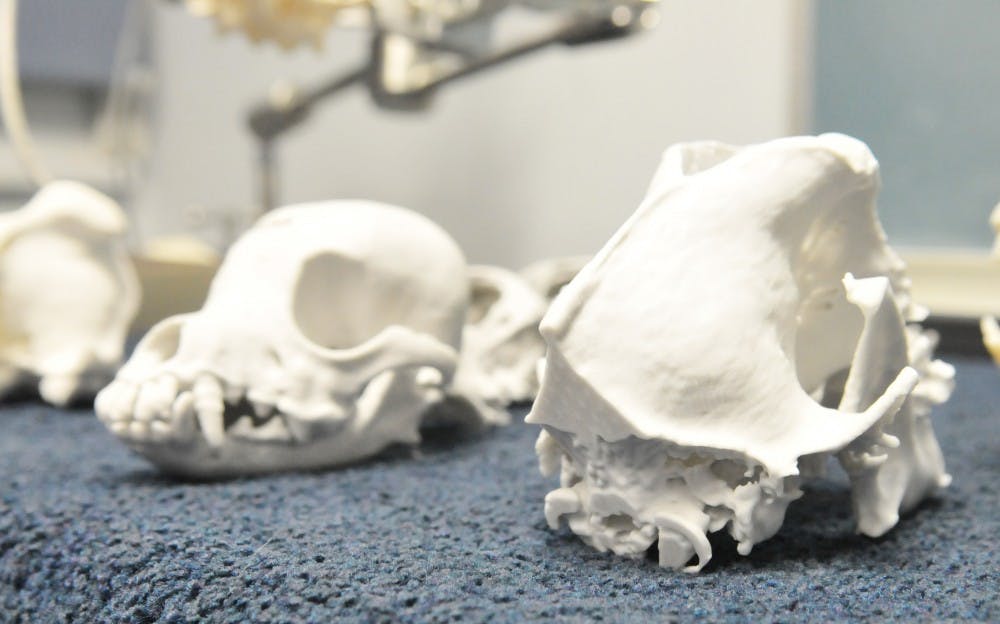
Animal health and architecture aren’t two fields that you would expect to interact. But since PennDesign acquired new 3-D printers this fall, neurologists at Penn’s School of Veterinary Medicine have been working closely with the School of Design to print 3-dimensional models of dog and cat skulls that aid them when performing brain surgery.
Related: Researchers develop treatment for dog blindness
Last October, Evelyn Galban, a neurologist at Penn Vet’s Ryan Hospital, faced the challenge of removing a bone intrusion from a puppy’s skull that was pressing upon the dog’s brain. Milly, a bearded collie, was just eight months old at the time. Galban’s team planned to remove the entire top portion of Milly’s skull and then replace it with an artificial implant.
“If we had a way to form [the implant] before surgery, that would make the procedure shorter and lessen the risk for the patient. So that’s why we started thinking about a model,” Galban said. “Finding a way to practice, to see it in real life.”
Related: Veterinarian to study the other side to dog petting.
PennDesign’s Fabrication Lab purchased two new 3-D printers, called ProJet 660Pros, last semester for graduate students to use when printing models of their designs. The machines construct models out of layers of gypsum — a powdery plaster material — and they are even able to print with a full range of color.
“Typically what we see here on a day-to-day basis are conceptual ideas of architecture,” Stephen Smeltzer, PennDesign’s digital fabrication manager, said. “Students are pushing the limits of what is possible within design using these machines.”
Penn Vet has been pushing the limits of these machines even further.
When the neurologists Googled “3-D printing at Penn,” they came across the Fab Lab.
“Out of the blue, the vet school got in touch with us and they started giving a more practical use to the printers,” Smeltzer said. “Now we’re going from working with conceptual models to functional printing. It’s pretty exciting to find ourselves in both camps.”
The neurologists used computer software to create a 3-D rendering of Milly’s skull from a CT scan. They sent the image to PennDesign, where the skull took about six hours to print on the ProJet and nearly two days to complete using the fused deposition modeling printer, which creates stronger pieces than the ProJet and can incorporate moving parts, such as gears and hinges.
Galban ultimately favored the ProJet’s product because the gypsum material is bonded by a soft acrylic on its interior and is sealed on the surface with a substance Smeltzer compared to super glue. The hard exterior and softer interior produced by the ProJet formed a substance that was similar to real bone.
Although Milly ended up receiving surgery elsewhere, surgeons at Penn Vet successfully practiced removing the bone mass on the ProJet model. This encouraged further collaboration between PennDesign and the neurology team as they printed additional models for their patients, including a Labrador with a brain tumor, a cat with a dislocated palate and a Yorkshire terrier named Tinkerbell who suffered a skull fracture. All of the patients received treatment and are doing well.
Galban and her team are working on publishing information about their use of these models — a method that has no precedent in veterinary literature, she said. In the future, they hope to print models of pet vertebrae that will be able to bend and articulate. These models would be printed on the FDM printer, due to their movable parts.
While the printers enable groundbreaking contributions to the veterinary field, 3-D printing is also having a massive impact on architecture, according to PennDesign instructor Mikael Avery. This semester, Avery is teaching a course on digital fabrication at PennDesign.
As technology advances and the prospect of printing with metal becomes possible, components of buildings will be printed and used for construction in future years, Avery said.
“What limits the 3-D printer in architecture now is that [it uses] mostly plastic, and it’s small. But assuming that we could get away from that, there’s a lot you could potentially do with it,” Avery said. “We can actually start making structurally sound connections.”
Related: Professors question enforceability of 3-D printer legislation
Although PennDesign students and Penn Vet faculty are now sharing use of the printers, Smeltzer emphasized their primary purpose.
“First and foremost, they are for our students,” Smeltzer said. “Whenever we can, we try to help the greater community at Penn as well.”
The Daily Pennsylvanian is an independent, student-run newspaper. Please consider making a donation to support the coverage that shapes the University. Your generosity ensures a future of strong journalism at Penn.
DonatePlease note All comments are eligible for publication in The Daily Pennsylvanian.





